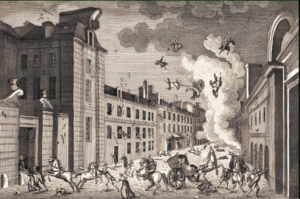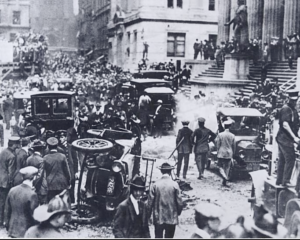I have written before about the early British EOD facility on Duck Island, a short distance from Downing Street, at the bottom end of St James’s Park, London. There, barely 100m from 10 Downing St is a small Island at the end of the lake, with a link to the road over a bridge. The facility was established by Colonel Majendie and his assistant Dr DuPre in about 1894. Col Majendie, had been working for the Home Office as Chief Inspector of Explosives for over 20 years by then having been first appointed in 1871. During that time he had dealt with a wide variety of IEDs and associated investigations, and developed some C-IED procedures. But the world was changing. Following a visit to Paris that I discussed here and here, he pushed hard for some similar facilities to the four French EOD facilities dotted around Paris at stratgic locations. The context at the time was an upsurge in anarchist bombings around the world. The 1890s were later described as “the decade of the bomb”. Majendie had undertaken overseas liaisons before, includng with the US authorities during the Fenian campaigns of the 1880s (many of the IEDs were made in the US and shipped to the UK, with US based support). Majendie reviewed the French EOD techniques and liked what he saw.
Majendie recommended three such facilities be established in London, one on Duck Island to be adjacent to the seat of government, one in “The Gravel Pit” in Hyde Park, adjacent to the district of Oxford St and Mayfair, and one in the moat at the Tower of London, covering the banking district of the city. Duck Island was the first and I believe that the Hyde Park facility may have existed as well, but I can find no evidence or suggestion that the Tower of London site was ever set up. The facilities were housed in wooden sheds, (like in Paris) I believe with some form of earth mound in the manner of the French facilities. I understand that amongst the equipment in Duck Island was a hydraulic press and a mercury bath contraption for lowering an IED into a mercury bath, dissolving the solder which held together some spherical-shelled anarchist devices. Other devices were dealt with at Woolwich Arsenal Laboratories in some circumstances in a proofing lab there, which also had a blast proof cell.
The EOD facility at Duck Island (that’s my description, not Majendie’s) was operational from November 1894 and was still apparently in use in at least 1914 when some suffragette devices were taken there. IEDs were moved to the facility in the hand cart I described here or later in a specialist vehicle provided by the Army. I don’t know when it fell into disuse. However in the 1980s the derelict wooden shacks were still there, hidden amongst rhododendron bushes and out of site, out of mind.
At this stage, for reasons that are unclear the Army was tasked with removing the facility, and that task fell to the Royal Engineers. A recce of the site was undertaken, and the remnants of the facilty (fundamentally a rotting wooden shed and its contents) was taken to Chatham and subsequently and regrettably lost or scrapped. However in the last few days I have been given sight of some photos taken by the Royal Engineers on the recce, now held by the RE Museum . Regrettably the Royal Engineer’s Museum own the photos and have not given me permission to republish them without a not insignificant licence fee. This website simply doesn’t have the budget for the license fee requested, so all I can say is that the photos appear to show what I believe is a hydraulic press, probably installed by Majendie in 1894. The photos are not too clear but the press appears to be somewhat more complex than the French version that I showed an image at the earlier link. There appear to be a number of levers which may have been able to be adjusted remotely by attaching lines. My assessment is that both the French and the British presses were used to “crack open” devices semi-remotely. By this I mean set up with a specific action prepared, then activated from a distance by means of a rope or line on a lever, activating the press. A typical anarchist device was contained in two halves of a metal sphere, soldered together. It may be that a variety of other IED containers, such as tins and boxes could have been opened remotely by this method. The lightweight wooden huts were cheap and easily repairable and the earth mounds would have been designed to stop shrapnel.
Without more detail, which I’m investigating, I cannot tell more, and I hope to persuade the RE Museum archive to allow me to reproduce the photos without the current expense they ask for.
The use of a hydraulic press is interesting. Majendie would have been very familiar with such presses, his role as Inspector of Explosives meant he investigated industrial explosive accidents and he developed much of the legal regulations surrounding explosives manufacture. Presses were used extensively in the explosive industry to press explosives into shape in gunpowder mills. Presses were also used for some explosive testing. As a former Superintendent of the Woolwich explosive laboratory, Majendie would have been familiar with their use.
By their nature presses are pretty resilient pieces of equipment – take a look at the hydraulic press channel on YouTube for a feel of what they are capable of.
Some key points :
- The facility then was a copy of the French facility, to some degree, and the French EOD/C-IED methodology appears to have been utilised (with variantions) by Majendie and Dr DuPre from 1894.
- The site was operational for at least 20 years.
- The British and French were not the only EOD operators active in the 1890s in C-IED. See details of New York’s Owen Eagen here http://www.standingwellback.com/home/2012/1/14/the-eod-operator-who-dealt-with-more-ieds-than-anyone-else.html
- The facility remained derelict until the 1980s or 1990s but was then demolished and scrapped. The organisation sent to deal with it probably had no clue as to its historical importance.




